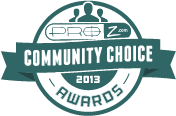As a follow-up to this week's raffle (congratulations to our winner Marina Meier!), we wanted to share the story behind what we've been calling "the veiled booth."
 |
| This set-up is good enough, if far from ideal. |
A few months ago, Judy had a conference interpreting assignment at a large Vegas hotel. The number of attendees was well in excess of 5,000, and interpreting services were provided in six different languages using table-top booths, which are less than ideal (fine, that's an understatement). The interpreting console was quite odd and Judy hadn't seen a set-up like this in a long time. For instance, there was a stand-alone microphone with an on/off button, but not the traditional cough button. However, here in the US, conference interpreters learn how to roll with the punches, and the set-up was functional and there were plenty of technicians to ensure good sound. Even though the interpreting conditions were far from ideal, the first day went quite well. We had individual screens on the tables that showed live footage of the
 |
| Just outside the booth: it's a party! |
speakers, but not of the videos or any PowerPoint slides, but we could see that through the main window of the booth, so it worked. However, this event also featured a DJ, so it was very challenging to get the audio feed through the headset with the hip-hop music at full blast, and we usually could not hear ourselves interpret. So the conditions were difficult, but certainly not impossible.
Judy did notice that a lot of the relatively rowdy attendees were unsure of what these table-top booths were for, and kept on walking up to us to ask us questions and to try to plug in their cell phones, which was incredibly distracting. The event organizers must have noticed that, because the second day of the event, we came back to find "the veiled booth."
 |
| Say hello to the veiled tabletop booths! |
It sure seems like the event organizers decided to section off the sides of the booth that was open to the ballroom. This seemed like a good idea because it would prevent attendees from wandering into the interpreting booths. However, what we can't figure out is the black veil that's securely fastened to the front and the sides of the booths via very strong velcro strips (and many of them). We were basically stuck without a way to see the stage. We did have the aforementioned screens, but we could not see any videos or PowerPoints that the presenters were showing (and there were quite a lot). In order to interpret those, we had to get up, headset and all, and try to stretch our necks to see. This made our work very difficult indeed, but we persevered. We couldn't find the conference organizers to have a conversation about the veiled booths, so we just worked with what we had. The show must go on.
What do you think, dear colleagues? Would you have been able to work with this? We'd also love to hear about any challenging situations that you have run into at conferences. Please leave a comment and share your experiences!
























3 comments:
Hi, in México, we work under that conditions most of the time. You should come here and see how we work. Full booths on the other hand are so small and have no ventilation.
Kind Regards,
Patricia Verdaguer
Las Vegas seems to be the place for the weird to happen. I once had NO BOOTH at an event there. The organizers were short one booth. Since it was a 30 minute stint, I went on anyway.
@Patricia: Oh wow, that sure does make things very complicated. We'd love to come see how you work (might actually be in Mexico City this summer). We've worked in full booths that do have great ventilation, and it probably depends on the make and model. Congrats to you and all your colleagues to making everything work under difficult conditions, too!
@Gio: No booth? Crazy, girl! And of course, experienced conference interpreter that you are, you just went ahead and did it. Well done.
Post a Comment